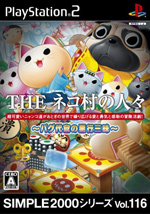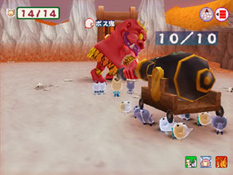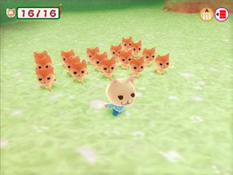Simple 2000 Series vol. 116: The Nekomura no Hitobito
 Vingt-et-un Systems is showin’ em how it’s done. The Genshijin – just about to be released in the US as The Adventures of Darwin – was the highlight of D3’s Simple 2000 release schedule in 2006, and the peak of VSC’s creative output to date. This year’s spiritual sequel, The Nekomura no Hitobito, is even more polished and full of personality than The Genshijin, and it’s gone even further to demonstrate what can be done on the Simple 2000 budget.
Vingt-et-un Systems is showin’ em how it’s done. The Genshijin – just about to be released in the US as The Adventures of Darwin – was the highlight of D3’s Simple 2000 release schedule in 2006, and the peak of VSC’s creative output to date. This year’s spiritual sequel, The Nekomura no Hitobito, is even more polished and full of personality than The Genshijin, and it’s gone even further to demonstrate what can be done on the Simple 2000 budget.
The game is set in an Edo-era Japanese village populated not by humans, but by anthropomorphic cats. The Genshijin, for those unfamililar, was heavily based on Nintendo’s Pikmin series. And here, too, you directly control the leader of a team of these villagers. They follow you around as you navigate obstacles, and they attack enemies once you give the command to swarm.
You’re in the employ of the town’s governor, the corrupt canine Magistrate Pug. At the outset of the game, the princess Nekohime has gone missing, and though it’s obvious from the start who’s responsible, Pug denies any involvement and instead sends you and your employees on treasure-hunting errands. You travel through five different levels surrounding Nekomura proper, each with its own (sometimes predictable, though effective) theme.
The entire game is presented in a sort of candy-colored soft focus that would be perfectly at home in a full-priced release. The cartoony style benefits, rather than suffers, from the relatively simple geometry of the environments and characters. Animations are even more smooth and well-tuned than those in Genshijin, and while the constant meows from your cohorts might grate after a while, they’re generally adorable. All the enemies are, too, and even the villainous Pug can’t help but be harmlessly cute. Plus, the game is full of sugar-sweet 2D illustrations of its locales and characters, plus the many items you can locate and create.
The Genshijin had the player’s focus divided evenly between finding ways around barriers and effectively defeating sometimes-tricky enemies. Here, there are no longer weapons to equip or detailed combat encounters. Rather, most combat is resolved by simple melees, and the outcome is usually decided your strength in numbers. The threat of having one’s army offed by a single enemy isn’t present here. Rather, when an enemy hauls off with a swing of his daikon radish, you’ll be more worried about whether you’re near any bottomless pits or water hazards, because a single blow can knock your troops around but good.
Instead of Genshijin’s weapons, here, there’s a selection of jobs to which you can assign your villagers. Messengers can run fast, acrobats jump high, miners can break through barriers (actually, giant rice crackers!), firefighters can handle flaming items and brave infernos, and so forth. Your troops can be divided into as many as three separate squads, which can be assigned different jobs and controlled one group at a time. This adds a new dimension to Nekomura’s puzzles: quite a few of them involve splitting your team up to carry out multiple parts of a task in coordination.
Each level ends automatically when you find whatever item Pug sent you to fetch, but you can return as many times as you like to collect items or seek out hidden pathways. As your party gains abilities, you’ll also gain access to previously-blocked areas in levels you’ve already explored.
Enemies drop various goodies upon death, just as in Genshijin, though you can’t use them directly this time around. Most items you can pick up are composed of several different ingredients, which you can combine in your item-making machine to produce Japanese meals (health restoratives) or decorations for your boss-cat’s room. While none of these are essential to getting around in the game, the process can become pretty addictive, especially as you find and collect more of the scrolls that reveal more and more recipes. A few of the trinkets require ingredients that are only available from items that are rare drops, which ensures some extra oomph for the collector who likes to go the extra mile. Between opening up new passage ways on multiple visits to levels and hunting that last ingredient to make that cool new recipe, Nekomura has a satisfying momentum. There’s a good deal less loading than in Genshijin, too, which makes extended sessions much more bearable.

The Genshijin could be quite difficult at times, with enemies content to squish your party all at once and many sticky corners that tended to trap cavemen. Nekomura is comparatively smooth sailing: the difficulty has been reduced as a whole so that you’ll spend more time solving puzzles and making expeditions for ingredients than picking yourself up after a defeat. Watch out for that last level, though. While its spooky theme is especially cool, it’s got dodgy platforming and relatively vicious enemies that can easily spell multiple retries. And while the camera requires less babysitting than in Genshijin, thanks to larger and relatively wide-open levels, one would be best advised to simply leave the right stick alone when the camera’s tracking automatically through tighter passageways. When you fight the camera, it fights back, and it’s a recipe for frustration.
There is a language barrier to account for if you’re not Japanese-literate, as there’s very little game text in English. But the game’s items and level layouts are so iconic and easily-digestible that figuring things out shouldn’t be a problem for any experienced player.
So while a few of Genshijin’s flaws are still present here, they’re in reduced form, and the good bits have been shined up and made quite a bit more inviting. There’s nothing earth-shaking or essential here – just a good, solid, adorable game with enough to collect and explore to last you ten or fifteen hours.
